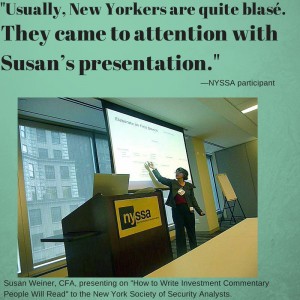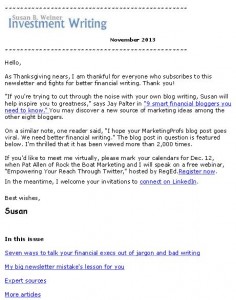I invited Jim Blankenship of Blankenship Financial Planning in New Berlin, Ill., to participate in a Q&A about his blog because I was struck by the depth of material on his blog. When I tweeted a question to him about his blog post explaining the file-and-suspend strategy for Social Security, he quickly tweeted back with a link to a blog post answering my question. I imagine it’s powerful to have this kind of information easily accessible.
This is the second in a series of Q&As with advisors who blog. The first was with Michael Kitces of Nerd’s Eye View. If there are other advisors whom you’d like to hear from, please let me know.
Q. When did you start your blog, Getting Your Financial Ducks in a Row—and how did you choose your focus?
A. When I started in April 2004, I was sending a paper newsletter to my clients (first quarterly, then monthly), so I just took the newsletter articles and blogged them. In late 2008, I started specifically writing articles for the blog.
I focused first on tax laws and IRAs because my clients had specific questions about these areas. A bit later, I added the Social Security focus. I have focused on these three areas since then, but always writing for my audience’s interests. When they send me questions outside of these three areas, I write about them as well. Sterling Raskie joined the firm in 2012, and one of his primary areas of focus is insurance, so he’s been writing about that quite a lot.
Q. How has your blog brought you new business or improved your existing client relationships? Please explain and quantify, if possible.
A. It’s rare these days to have a new client come to me who has not read either my blog or syndicated articles from it. My articles are syndicated on sites including Forbes.com, TheStreet.com, Morningstar Advisor, and FiGuide. The great benefit is that folks who’ve read my writings already understand much about how I work, who I am, and my areas of expertise. In addition, from having read my articles, there is a level of trust already built into the initial conversation.
This has helped with long-distance relationships, which have increased significantly over the past two to three years. We now routinely have clients that we exclusively work with long-distance. They account for something like 40% of new clients. In contrast, prior to starting the blog, long-distance clients only came about when someone local moved away.
Q. What blogging techniques or topics have most helped your business?
A. The blog’s niche focus on taxes, retirement plans, and Social Security has reinforced the fact that we’re experts in these areas.
Keeping to a schedule has also helped. I started with a haphazard approach to blogging, without any schedule. I soon recognized that I needed to be more consistent in my blogging efforts, so I set the goal of writing three articles per week, one on each of my focus areas. Sticking with this schedule has helped me to manage the time to blog, as well as letting my readers expect a level of activity. As with all things that take time, you will make time for the things that you put a priority on, and I have (since late 2008) always put a priority on keeping that schedule.
I maintain lists of topics to write about, spurred by reader questions, real-life client situations, and articles I’ve read, so I never run out of things to write about. Sometimes the mix of topics differs week-to-week, but the primary focus areas are still represented in my writing.
Q. What are three of your favorite—or most effective—blog posts? Provide the titles, URLs and a comment about why you included them.
A. I don’t really have any favorites. Here are three of my articles that have had the most hits.
Charitable Contributions From Your IRA – 2012 and Beyond — this explains how the elimination of the Qualified Charitable Contribution option changes the tax effect of making contributions to charities from your IRA. Of course, the tax law was extended, so this now applies to 2014 now—until the law is extended again.
The File and Suspend Tactic for Social Security Benefits — as the title suggests, this is a straightforward explanation of the tactic.
A Little-Known Social Security Spousal Benefit Option — this explains the option where a higher-wage-base spouse files a restricted application to receive half of his or her spouse’s benefit at Full Retirement Age, but delays filing for his or her own benefit to age 70. Not many folks understand this one, so I’ve written several articles to help explain it. I still get questions every week.
Q. What’s your best tip for advisors who blog?
A. Just do it. It’s not rocket science. Find your focus, be consistent, and put a priority on writing, even if it’s once a week or once a month. Over time, this will build up to a significant body of work that potential clients can refer to, and it will make a difference in how you interact with people.
In addition, use all of the tools available — Twitter, Facebook, LinkedIn, Google+ and Pinterest — to promote your blog posts. Explore using various plug-ins to your blog to push out your articles, such as RSS, email subscription, and automatic tweeting. These free tools are worth their electronic weight in gold, in terms of promotion and reaching out. Answer questions via each tool, and strike up conversations.
Track your traffic – you can’t know if you’re getting through if you don’t track it. I use a combination of Google Analytics, WordPress statistics, and Bing webmaster tools to track traffic.
Always respond to comments on your blog posts in a timely fashion — this keeps the conversation going beyond your initial writings. It’s no different from returning phone calls.
Note: This post was updated on Jan. 14, 2014, to correct a typo.




 For example, I created a text block to accompany my virtual book tour’s links, as in “
For example, I created a text block to accompany my virtual book tour’s links, as in “


